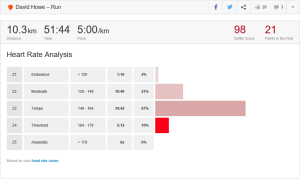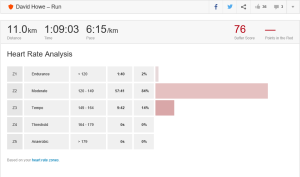Here we go again, folks. Happy New Year to both of my readers. 2016 was an excellent vintage for running in the end, but now it’s time to get 2017 up and running in preparation for what lies ahead.
I’ve been reading a book since the start of December called “Beyond Training“. It’s been an interesting book which has given me some inspiration for how to approach my training for this year’s races. I liked it, mainly because it takes a fairly holistic view on how to improve performance.
There are a couple of the main areas the book highlights which I plan to adopt in my approach to training this year, and I’ll talk about those in a minute. I’ve wanted to shake things up for a while, as my training recently has been more a case of simply stepping out of the door to run as frequently as I can afford to. Inevitably, this leads to a situation where I can continue to complete races, but my ability to improve in them feels like it is becoming more and more limited. I think that, most, if not all runners reach this point from time to time. So I believe it’s important to not allow yourself to settle for what is, but to think about how to evolve and give yourself an opportunity to improve. What I liked about this book is that it isn’t a strict regime to follow, it’s more of a collection of things which can contribute to improved performance. Here’s me take away list of things I’m going to use this year
80/20 Training
The book talks about how most amateur athletes, and I do feel weird using that term about myself, think that they have a structured approach to training and split sessions into high and low intensity. The sprint session, the long Sunday run, the mid week tempo etc. In reality, the author claims that the probability is the high intensity sessions are not high enough and the low intensity are not low enough. The consequences of this are that muscles don’t recover strong enough between sessions, training effect plateus after a while and there is a long term risk in endurance sports of health issues if this type of training carries on for a long time.
He advocates for a more polarised view of training, one where 80% is done at very low intensity, or zone 2 as most of us know it in heart rate training categories. The other 20% should be done at high intensity, zone 4 & 5 in short periods to provide a truly differentiated training effect. He still recognises the need for long runs for endurance, but these should be done in the 80% category and at low intensity. All this makes sense to me as an ultra runner.
This translates for me, into an approach where I have dug out my HR monitor strap for my Suunto and put it to good use. My runs over the past three weeks (The week where I was almost killed by Man-fly aside!) have been mostly slow, steady paced affairs in Z2. It is damned hard to stay at such a low HR. Zone 2 for me is around 120-149bpm, so aiming for an average of something around 130bpm is pretty tough to maintain, considering my comfortable running pace has me at around 160bpm. It’s a marginal difference in HR, but I can see how it has an impact already. I’ve enjoyed the lower intensity much more and it gives me time to settle into a run without pressure to go faster, which is what I would normally be doing, at least mentally, if not physically.
- Usual pace HR analysis
- Low intensity run HR on similar route
Cross Training
This has been a huge hole in my training over the past couple of years. I’ve fallen into the trap of thinking that simply going out and running a high volume of miles is enough. It isn’t. Therefore I need to do something different. The book talks a lot about high-intensity interval training, or HIIT, and the need to develop strength and endurance in many forms, and not just activity specific training.
My plan is to do two things, firstly, twice a week I am going to do an HIIT session. One for running and one for general strength work. The running will take the form of hill repeats or sprint intervals, and the strength work will be focused on core, abs, and leg strength. I found the annoyingly good looking and fit “The Body Coach” recently. His 20-25min sessions are a perfect workout and are currently doing the trick for me. I mix them up to get a range of exercise, but they immediately highlight my weakness in strength terms and I’m intrigued to see the results of sticking to this for a month or two over the start of this year.
The second adaptation I’m making is to introduce yoga back into my routine. I used to practice yoga a lot before I ran, but strangely I haven’t returned to it since my running has taken off. The flexibility it provides and also the stress eliminating aspect of it is probably exactly what I need at the moment. My life is pretty hectic with family and works responsibilities, and I feel it in the way of tightness in my neck, shoulders and upper spine. My hips are also rock solid and need to see daylight again, so I’m hoping 3-4 sessions of yoga a week will make a big difference too. Nothing crazy, just a 30-minute program early morning to wake up and stretch out those bits of me which don’t normally get a stretch.
Diet and Lifestyle
My diet has been, in general, pretty good over the past few years. At home, we naturally eat an organic, mainly veggie and even vegan diet, without trying too hard. Alcohol is a rare treat these days and post-Christmas, I’m ready to stay dry for several months in the interest of improving my fitness. My two main weaknesses are sugar and caffeine. I can consume both in considerable quantities and I know they are really bad for me. It is going to take discipline to eliminate them from my diet and I think wholesale reduction might be more achievable for now.
The book also talks about nutrition in some detail and the supplements that can help with specific training impact. Last summer I used to make myself a fresh smoothie every day and add into it vitamin C, zinc, a micro-nutrient mix and some milled flax seed. My ever patient partner, Nichola, who is an avid nutritionist has been pressing me to take a whole range of nutrient supplements for a long time, so it’s time for me to start to listen to her, which I’m certain she will relish for the “I told you so” opportunity.
Sleep is a major factor in recovery too, which most people know. The book talks about many things which influence sleep, including blue light which we get from all the many devices and computers we use. I’m now the proud owner of a pair of glasses which filters out that blue light, in an effort to help improve sleep when it comes. Minimising phone use and a bunch of other things will also play a part, but I already know that is harder to achieve.
I also own a Compex machine, which I bought last year to help with minor muscle injuries. They promote blood flow amongst many other things and are a useful addition to the training plan. I’ve started to use mine a couple of times a week to help with strength building in certain muscle groups. They are low impact sessions from a cardio perspective, so they fit with my overall 80/20 plan, and again, I will see how it impacts me over time.
The only other thing I’m hoping to do in modification of my training this year is to spend more time out in the hills on my long runs. I suffered greatly in TDS last year due to the lack of appropriate training for mountainous races. I’m determined to make an impact on this over the coming months, so hopefully I will have some adventures to share with you soon.



